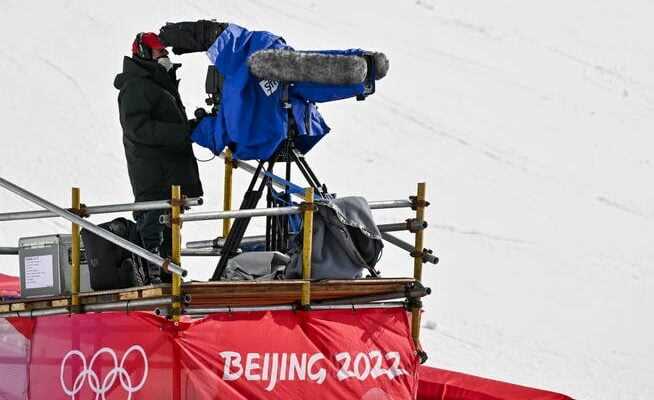Despite the large time difference, the attention paid to the SRG Olympic programs was high. But they can’t match the record values from football, and the competition is getting stronger – SRG is under pressure.
The broadcasts of the ski races traditionally guarantee SRF above-average attention.
The Winter Games in Beijing were not only a success for the Swiss Olympic delegation, but also for Swiss television. In the wake of the Swiss success, SRF sailed to good ratings. Between 2 a.m. and 7 a.m. in the German-speaking part of Switzerland alone, an average of 49,000 viewers watched the live transmissions from the Far East on television or via mobile devices.
At the last Winter Games in Pyeongchang in 2018, there were 41,000. The average number of viewers for “Beijing heute” magazine in the evening prime time was a good 200,000 (market share 14 percent). These figures do not include the last three days, which, however, are unlikely to fundamentally change the picture.
Odermatt’s gold run top
The top event was Marco Odermatt’s gold run in the second run of the men’s giant slalom, which attracted a peak of 762,000 spectators (85.4 percent market share). The average value of the broadcast was 482,000 viewers. For comparison: Half a year earlier at the Summer Games in Tokyo, the 100-meter final with the sprinters Mujinga Kambundji and Ajla Del Ponte was the top event. It was seen by 386,000 people. The tennis final with Belinda Bencic in second place attracted 323,000 spectators.
The realization is not new: Switzerland is a winter sports nation. The broadcasts of ski races in particular traditionally guarantee SRF above-average attention. That may justify the expenses of 18.4 million Swiss francs. That’s how much the SRG, including the rights fee, cost the Winter Games in Beijing.
Compared to football, even ski racing in Switzerland is a beggar. Since the measurement method was changed in 2013, 30 of the 50 most-watched TV shows are football broadcasts. The list is headed by the Swiss national team’s first game at the 2018 World Cup in Russia against Brazil (1.618 million viewers).
The best-ranked ski race is the men’s downhill World Cup in St. Moritz in 25th place (1.076 million). The two World Cup finals with the Swiss national ice hockey team rank even earlier (2013: 1.178 million; 2018: 1.079 million). Odermatt’s gold run doesn’t make it into the top 50.
The figures in Germany paint a similar picture to that of the SRG. According to the Second German Television, an average of 1.77 million viewers watched the broadcasts from Beijing. At ARD, which shared the rights with ZDF, there were 1.57 million.
The men’s toboggan race (5.15 million viewers) achieved the highest viewing participation on the German channels on the first Sunday. However, these numbers do not come close to those of football either. 27.36 million watched the defeat of the German national soccer team against England in the round of 16 last summer live on TV.
CH Media Group is catching up
Despite the rapidly changing TV landscape, SRG is still the market leader in Switzerland. In 2021, it achieved a market share of 33.5 percent. The CH Media Group, with its 13 channels, now has a cumulative 26.3 percent.
But especially in live sports reporting, SRG has continuously lost ground in recent years. The Swisscom broadcaster Blue-TV has taken away the rights to the soccer Champions League. MySports from Sunrise-UPC has been the market leader for several years when it comes to national and international ice hockey.
Due to the gradual loss of importance, the position of the fee-financed SRG in politics is coming under increasing pressure. The SVP’s halving initiative, which has set itself the goal of massively restricting the broadcaster’s financial leeway, has found support even in the political center. Success reports such as the latest figures from Beijing are all the more important for SRG.
